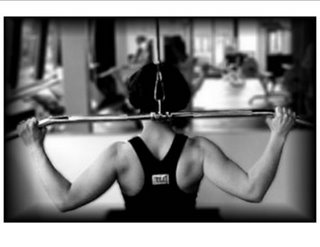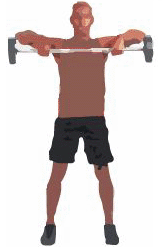Nothing is worse then watching people do the wrong exercises at the gym. Most people don’t even know they are doing the exercises wrong. Then they wonder why their joints ache and their results lag. Enjoy the count down….
- Lat pull-down behind the head.This exercise is done sitting on a machine with a weighted, cabled bar overhead. You reach for the bar, then pull it down behind your head and neck.”So many things can go wrong” with this exercise, says Warpeha.Alignment is number one: Only people with very mobile shoulder joints can keep their spines straight enough to do this exercise properly.”Most people’s shoulders aren’t that flexible,” Warpeha says. So the move can lead to shoulder impingement or worse, a tear in the rotator cuff, he says
2. Military press behind the head. In this exercise, you lift the weights or barbell starting from behind the head at shoulder level, and press up and down behind the head.
It can cause the same problems the behind-the-head lat pull does and should be avoided, says Warpeha. It’s also wiser to choose an exercise that targets several muscle groups at once, rather than putting all the strain on the shoulders.
“We should treat the shoulders (as well as the biceps, triceps, and calves) like ornaments on a Christmas tree,” says Scott Danberg, MS, director of sp and fitness for Pritikin Longevity Center and Spa in Aventura, Fla. “Give them some attention, but concentrate on large muscle groups when doing an exercise.”
3. Upright row.Pulling weights, a barbell, or a weighted cabled bar up under your chin is a big no-no, says Saremi, a podiatrist and editorial staff member of the Aerobic and Fitness Association of America’s American Fitness magazine.
“When people pull their hands (carrying the weight) up to their chin, they are going to compress the nerves in the shoulder area, impinging the shoulder,” Saremi says.
A safer alternative: Instead, do a front or lateral shoulder raise, lifting weights out to the front or side of the body. Even better, try the bent-over row: Bending forward at the hips, hold weights down beneath your shoulders, then lift toward sides of your body. This exercise is much safer, and targets all the muscles of the upper back as well as the biceps.
4. Lying leg press with knees bent too deeply.Lying on your back with your feet on a weighted plate, you push the plate up and bring it down, with the aim of working the quadriceps, hamstrings, and glutes. The problem with this exercise comes when you bend your legs too far.
“This can be very dangerous if you come down too deep,” says Warpeha.
That’s mainly because form falls apart. Your spine cannot maintain proper alignment when your legs come back too far, so the pelvis tilts and the lower back begins to take over. And the weight used is usually heavy enough to injure the back, causing strain to muscles or damage to disks. In addition, he says, bending your knees too deeply can injure or damage your knees.
If you want to do this exercise, Warpeha suggests a good rule of thumb: Keep your butt from rotating off the back of the machine, and don’t bend past 90 degrees at the knee and hip.
5. Any exercise done wearing the wrong shoes.Even if you’re doing everything else right, your efforts can be undermined by improper footwear, warns Saremi. Working out with the wrong shoes increases pounding on the joints, and can lead to injuries like plantar fasciitis or tendinitis, she says.
The key, experts say, is to choose a shoe that is specific to your activity and that suits your particular foot. They recommend shopping at stores specializing in athletic shoes, where you can seek advice from a knowledgeable salesperson. And don’t forget to replace your shoes when they show signs of wear.
6. Exercises done with the goal of spot reduction. People who do strengthening and toning exercises in an effort to trim fat from a certain area – thighs, hips, stomach, or arms – have the wrong idea. While these exercises can help firm muscles, if the targeted area still carries an extra layer of fat, it won’t look much different.
“You’re making the muscles stronger, but it’s not anything you’re going to visibly see when you look in the mirror,” says Warpeha.Fat loss cannot be isolated to one area, but is distributed evenly throughout the body, Danberg says. So you’ll lose a millimeter of fat from your chin whenever you lose a millimeter of fat from your torso. Doing 1,000 crunches won’t take more fat off your abdominals.
Cardiovascular exercise is the biggest calorie burner, but resistance training is a big part of the equation if you want to burn fat.
“When you build more muscle mass, you slowly increase your resting metabolic rate, burning more calories all the hours of the day that you’re not active,” says Warpeha.
7. Using bad form on cardio machines. Walk into any gym and you’ll see some people sweating through their treadmill, elliptical, or stair-climber workouts with their bodies hunched over and a death grip on the handrails.
“People will put a really huge incline (or high resistance) on the machine and then grab on,” says Saremi. “This is totally contraindicated.
“If you can’t run or walk with your hands off, you shouldn’t do it.”
She also notes that exercising in a hunched-over position can keep you from breathing deeply, and that the improper alignment of your spine can make the workout more jarring to your shoulders and elbows.
Use a natural gait, says Danberg. And “Don’t hold the handrails because it breaks the natural biomechanics of the body. We don’t go through life holding on to something.”
8. Always lifting with a weight belt. Bodybuilders have long used these belts to provide low back and abdominal support when lifting heavy weights. But now they seem to be standard equipment even for many occasional weightlifters.
“Too many people wear weight belts too often,” says Warpeha. “They should only be used when you’re getting 85% to 90% of your one-repetition maximum [for example, squatting with 300 pounds of weight if you’re a man]. Most people are not working at that level.”
Unless you have a back injury or another medical reason to use the belt, says Warpeha, the level at which the average person works doesn’t require a weight belt. And it can do more harm than good.
“When the belt is on, you’re not allowing your normal core muscles to get strengthened,” he explains. “If you get used to having that belt, you go into everyday life and try to lift groceries or pick the baby up out of the car seat and you can’t do it. You’ll never learn how to use your natural belt, your core, the abs, obliques, and spinal erectors (source).”
Make sure you aren’t the one doing everything wrong in the gym. If you know someone who has a background in fitness ask them to help you out; or better yet, if you have the money hire a trainer to teach you the ropes. You will never regret spending money on education that will keep you fit the rest of your life!
Adria Ali
(CES, PES, CPT, BS)




Leave a Reply